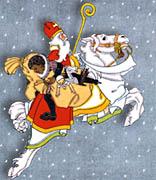What's it
to be?
Sint Nicolaas
or
Santa Claus
Sinterklaas explained
His legendary gifts of
dowries to poor girls led to the custom of giving gifts to children on
the eve of his feast day, 6 December. The companions of St. Nicholas (in Germany and Austria they are called
Knecht Ruprecht or Krampus) show the victory over evil. Together with his "pieten" he visits children to punish the
evil ones and to reward the good ones. The worst punishment is to be
taken to Spain in "zwarte piet's" bag out of which the good children
get the sweets (called "pepernoten", "taai-taai", or
"schuimpjes") and A few weeks before his birthday St. Nicholas comes to Holland on his steamer with all his "pieten" and the presents which they prepared in Spain during the year. This event can be seen on Dutch television. From his arrival in Holland till his birthday the children can put their shoes in front of the fireplace. During the night St. Nicholas visits all the houses by travelling over the roofs on his horse, traditionally a white/grey, and "zwarte piet" enters the houses through the chimney to put little presents in the children's shoes. Sometimes the children put straw, carrots and water near the shoe for the horse. On the eve of his feast
day St. Nicholas visits all children. After knocking on the door he
gives them a bag full of presents (if they were good children). Early in the morning of 6 December, when he has
visited everyone, he leaves and goes back to Spain, to come
With courtesy to the Duch embassy in Washington DC. They have a very
interesting Sinterklaas site. You will be able to find Sint Nicolaas
songs, stories, recipes and a lot more. http://www-astro.physics.ox.ac.uk/~erik/sint/sint.html
|
